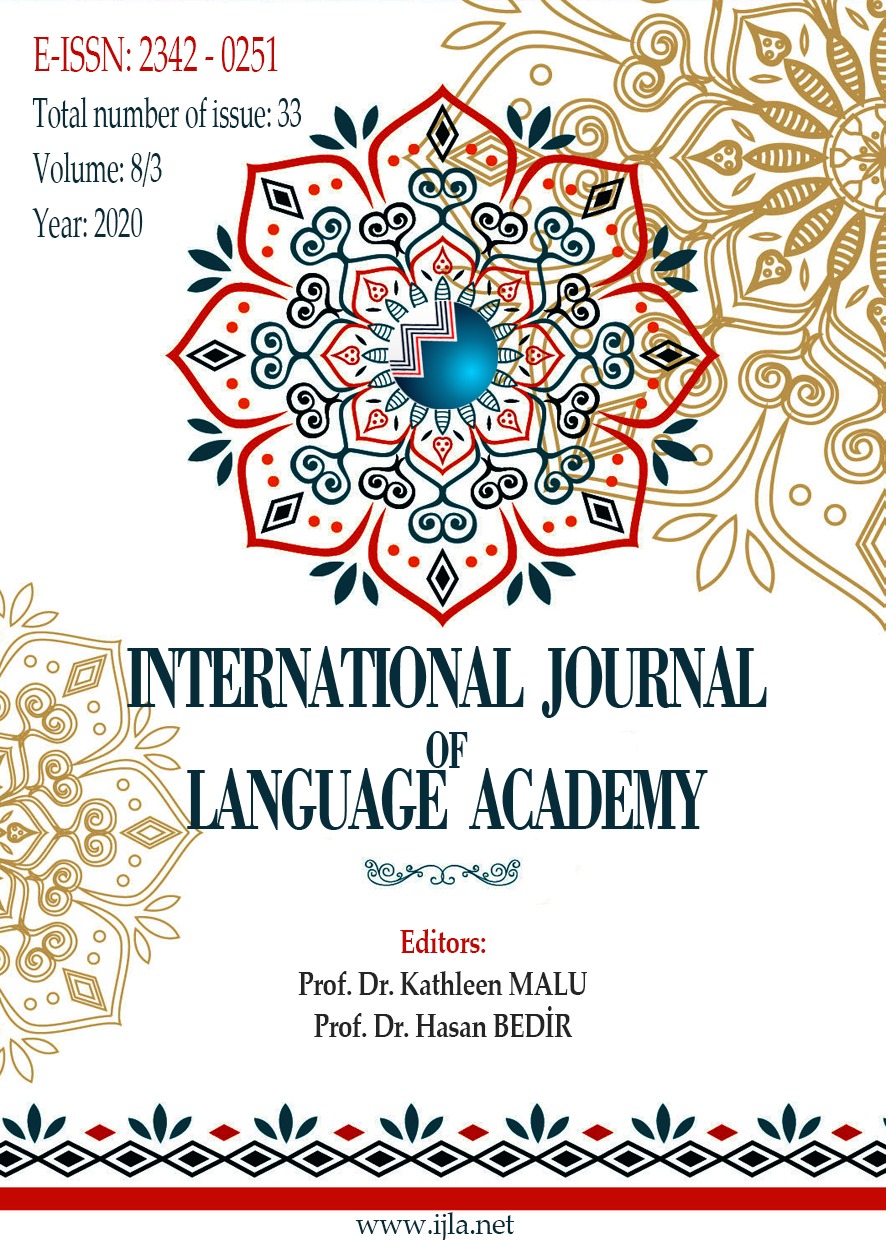İngilizce Öğrenen Öğrencilerin Derse Katılım Düzeyini İletişime Yönelik Aktiviteler Kullanarak Artırma
Author :
Abstract
İletişimsel Dil Öğretimi, yapıya ve doğruluğa dayalı geleneksel yöntemlere bir tepki olarak ortaya çıkınca, sınıflarda kullanılan aktiviteler de değişmiş ve rol yapma, grup çalışması ve proje çalışması gibi etkinliklerin kullanımı üzerinde durulmuştur. Geçmişte tercih edilen mekanik egzersizlerin yerini alan bu tür etkinliklerin kullanılmasının, derslerin öğrencileri motive etmede ve onları iletişim kurmaya cesaretlendirmedeki etkililiğine katkıda bulunduğu düşünülmektedir. Bu nedenle mevcut çalışma, iletişime yönelik aktiviteler kullanarak İngilizceyi yabancı dil olarak öğrenen öğrencilerin katılım düzeyini artırmayı amaçlamıştır. Bu çalışma tanımlayıcı bir vaka çalışması olarak tasarlanmıştır. Çalışma 5 haftalık bir süreçte uygulanmıştır. Araştırmanın katılımcıları Türkiye’de bir özel üniversitede öğrenim gören 12 alt orta düzey hazırlık sınıfı öğrencisidir. Çalışmada örnekleme yöntemi olarak kolayda örnekleme metodu tercih edilmiştir. Veri toplamak için iletişime yönelik aktivitelerin tamamından önce ve sonra yapılan öğrenci görüşmeleri, her hafta iletişime yönelik aktivitelerden hemen sonra öğrenciler tarafından doldurulan öğrenci öz değerlendirme formları ve her dersin sonunda araştırmacı tarafından tutulan ders raporları kullanılmıştır. Ders raporları, öğrenci öz değerlendirme formları ve öğrenci görüşmelerden elde edilen veriler ayrı ayrı analiz edilmiştir. Çalışmanın bulguları iletişime yönelik aktivitelerin İngilizceyi yabancı dil olarak öğrenen öğrencilerin İngilizce derslerine katılım düzeyini artırmaya yardımcı olduğunu ortaya koymuştur. Bunun yanı sıra, öğrencilerin etkileşim sürecinin başlangıcında endişeli ve gergin hissetmelerine rağmen, İngilizce iletişim kurabildiklerini fark ettiklerinde özgür ve daha rahat hissettikleri sonucuna varılmıştır.
Keywords
Abstract
As Communicative Language Teaching emerged as a reaction to the traditional methods that rely on structures and accuracy, activities used in the classrooms have also changed and the use of activities like role-plays, group work activities and project work has been focused. Use of such kinds of activities replacing the mechanical exercises which were preferred in the past has been considered to be contributing to the effectiveness of the lessons on motivating and encouraging students to communicate during the lessons. Thus the current study aimed to increase EFL students’ participation level through the use of communicative activities. This study was designed as a descriptive case study. It was conducted during a five-week period. The participants of the study were 12 pre-intermediate level students who were attending preparatory school in a private university in Turkey. Convenience sampling strategy was used while selecting the participants. Student interviews conducted with 5 randomly selected students before and after the use of all communicative activities, student reflection sheets given to the students every week after the communicative activities, and lesson reports written by the researcher after each lesson were used in order to collect data. The data gathered from the lesson reports, student reflection sheets and interviews were separately analyzed. The findings of this study revealed that communicative activities help to increase EFL students’ level of participation in English lessons. Beside this, it was concluded that even though the learners felt nervous and tense at the beginning of the interaction process, they felt free and more relaxed when they realized that they were able to communicate in English.
Keywords
- Ansarey, D. (2012). Communicative language teaching in EFL contexts: Teachers attitudeand perception in Bangladesh. ASA University Review 6(1), 61-78.
- Bassey, M. (1999). Case study research in educational settings. Philadelphia, USA: Open University Press.
- Burns, A. (2010). Doing action research in English language teaching. New York, USA: Routledge.
- Celce-Murcia, M., Dörnyei, Z., & Thurrell, S. (1995). Communicative competence: A pedagogically motivated model with content specification. Issues in Applied Linguistics, 6(2), 5-35.
- Costin, A. F. (2011). Communicative competence: A main goal in foreign languages teaching. Revista de Management şi Inginerie Economica, 10(2), 15-22.
- Dörnyei, Z. (2009). The 2010s communicative language teaching in the 21st century: The ‘principled communicative approach’. Perspectives, 36(2), 33-43.
- Farrell T. S. C. & Jacobs G. M. (2010). Essentials for successful English language teaching. London, UK: Continuum.
- Gay, L. R., Mills, G. E., & Airasian, P. (2000). Educational research: Competencies for analysis and applications. New Jersey, USA: Pearson.
- Kvale, S. (2006). Dominance through interviews and dialogues. Qualitative Inquiry, 12(3), 480-500.
- Larsen-Freeman, D. (2000). Techniques and principles in language teaching. Oxford, UK: Oxford University Press.
- Littlewood, W. (1981). Communicative language teaching: An introduction. Cambridge, UK: Cambridge University Press.
- McDonough, J., Shaw, C. & Masuhara, H. (2013). Methods and materials in ELT. West Sussex, UK: Wiley Blackwell.
- Nunan, D. (1991). Communicative tasks and the language curriculum. TESOL Quarterly, 25(2), 279–295.
- Richards, J. C. (2006). Communicative language teaching today. New York, USA: Cambridge University Press.
- Richard, J. C. & Rodgers, T. S. (1986). Approaches and methods in language teaching: A description and analysis. New York, USA: Cambridge University Press.
- Rocca, K. A. (2010). Student participation in the college classroom: An extended multidisciplinary literature review. Communication Education, 59(2), 185-213.
- Savignon, J. S. (2007). Beyond communicative language teaching: What’s ahead? Journal of Pragmatics, 39, 207–220.
- Savignon, J. S. (1991). Communicative language teaching: State of the art. Tesol Quarterly, 25(2), 261-277.
- Savignon, J. S. (2002). Communicative language teaching: Linguistic theory and classroom practice. In J. S. Savignon (Ed.), Interpreting Communicative Language Teaching (pp. 1-27). London, England: Yale University Press.
- Shastri, P. D. (2010). Communicative approach to the teaching of English as a second language. Mumbai, India: Himalaya Publishing House.
- Wang, Y. (2010). Using communicative language games in teaching and learning English in Taiwanese primary schools. Journal of Engineering Technology and Education, 7(1), 126-142.
- Willis, J. A. (1996). A framework for task-based learning. London, UK: Longman.
- Zhang, L. J. (2006, November). The ecology of communicative language teaching: Reflecting on the Singapore experiences. Paper presented at The Annual CELEA InternationalConference: Innovating English Teaching: Communicative Language Teaching.





